
By Tyler Rossi for CoinWeek …..
With the successful recent premiere of HBO’s House of the Dragon–a prequel to George R.R. Martin’s A Song of Ice and Fire (ASOIAF) series of fantasy novels and the hit HBO series based on it, Game of Thrones–the franchise has seen a revival in popularity. Fans have been given yet another opportunity to dive into the multilayered history and culture of Martin’s creation
Through his meticulous worldbuilding, Martin grounded the worlds of Essos and Westeros with realistic monetary systems. The first thing to note is that Martin chose not to include paper money in his world. As a result, there are no fiduciary currencies in Game of Thrones and all coins should be considered commodity money, with values based on their constituent metals.
 The various kingdoms in Martin’s stories use a dating system given as BC (Before Conquest) and AC (After Conquest), centered on the Targaryen invasion at Year 0. Westeros, for example, has overlapping pre- and post-invasion coinage systems. When the Targaryens invaded Westeros some 300 years prior to the original Game of Thrones TV series, they did not completely replace the varied coinage systems of the seven kingdoms. This blending resulted in a non-decimalized system that, as Martin described, is “more complex than actual British medieval coinage.”
The various kingdoms in Martin’s stories use a dating system given as BC (Before Conquest) and AC (After Conquest), centered on the Targaryen invasion at Year 0. Westeros, for example, has overlapping pre- and post-invasion coinage systems. When the Targaryens invaded Westeros some 300 years prior to the original Game of Thrones TV series, they did not completely replace the varied coinage systems of the seven kingdoms. This blending resulted in a non-decimalized system that, as Martin described, is “more complex than actual British medieval coinage.”
Based on the Gold Dragon, Westerosi post-invasion currency has three main denominations: the gold Dragon, the silver Stag, and the copper Penny. There are 56 Pennies to a Stag and 210 Stags to a Dragon. This means that 1 Dragon equals 11,760 Pennies. In conversations with the Shire Post Mint, Martin discussed how the Stag and Dragon should be compared respectively with the U.S. silver dime and the $10 gold eagle.
As part of his worldbuilding, Martin accurately wove economic theory into his stories, with inflation being caused by war and seasonal changes. Textual evidence from Martin’s books illustrates how the price of goods skyrocketed as a result of the War of Five Kings and the onset of winter. In fact, Westerosi food prices tripled by the end of the war. Additionally, 90 years prior to Game of Thrones, three gold Dragons equated to a comfortable annual salary. These were large gold coins Martin intended to be used only by the nobility as “big money” for large scale payments. The purchasing power held by a gold Dragon is multiples of a British gold noble, a comparable coin from the real-world medieval period. One noble was equal to 80 silver pence, or one month’s wages for unskilled labor in late 14th-century England. Also, a knight’s horse was worth 750 silver stags or roughly 3.5 gold dragons, while at the same time a war horse could be purchased for roughly 15 nobles in 1374 Britain.
The Shire Post Mint & George R.R. Martin
In 2001, Tom Maringer purchased over a ton of old coin dies, hubs, and tooling from a St. Louis pressworking firm. This collection, which included many pieces created by Stan Pearson, was used to found the Shire Post Mint, based in West Fork, Arkansas. After designing and striking high-quality fantasy coins for over two decades, Tom and his co-workers have produced four to five hundred designs in total!
In a process that started seven years before HBO even began production, Martin agreed to grant the Shire Post Mint the rights to produce ASOIAF coinage. In a recent telephone interview with Maringer, he stated that, despite Martin being very hands-off with the design process, the author stipulated that the coins should “adhere as closely as possible to the text of the books”. To that end, Tom and his team of artists have worked closely with Elio M. Garcia Jr. and Linda Antonsson, co-authors of The World of Ice and Fire: The Untold History of Westeros.
Maringer recounted how the Shire Post Mint created their first Game of Throne coin before even developing sufficient in-house engraving capacity by hobbing a Pearson hub into a blank die to create the bust and a series of Elizabethan-style punches to form the lettering. Thus, the Copper Star of Robert Baratheon was born. Maringer commented that Martin liked the design so much that he later wrote the coin into his books and how Martin has purchased hundreds of their pieces that he distributes to fans. Over the years, the Shire Post Mint has designed and produced 40 different coins in partnership with Martin.
When designing their more recent coins, the Shire Post Mint asks questions like Who or what would be depicted on the coin: a ruler, an idol, a god, a symbol, or simply text?, and What would the coins be used for: a monetary system, exchange of information, advertising for a new ruler? This helps ground their products within the logic of the intended fantasy world. After completing a 2D design, the engraver uses a pantograph machine to engrave the reverse design, which is later cleaned up by hand. Using homemade blanks, the Mint uses a set of four different types of mechanical coin presses: an antique manual screw press, an electric screw press, an electric knuckle press, and a powerful yet slow hydraulic press.
So how do these coins stack up? Notwithstanding that they are fantasy pieces, are these coins well-grounded in the Game of Thrones universe while also adhering to numismatic reality? Since The Shire Post Mint has such a large inventory, let us explore a handful of the most interesting pieces.
The First Coin
Here we have the so-called First Coin attributed to the First Men shortly after their invasion of Westeros over 12,000 years before the Targaryens arrived. Traveling over a land bridge called The Arm of Dorne, these actions mirror the real-world Stone Age migration from Asia to North America via the Bering land bridge. While eminently logical for Martin’s world, where the First Men were known to have bronze smithing, these coins do not have any true real-world contemporaries. If we follow the story’s timeline, this coin was struck nearly 9,500 years prior to the first real-world coin of the seventh century BCE Lydia.
Nonetheless, these coins do share a sense of design continuity with those early Lydian coins and feature a simple uniface design set within an incuse square. However, Lydian coins were stuck from a naturally occurring alloy of gold and silver called electrum while these are struck in bronze.
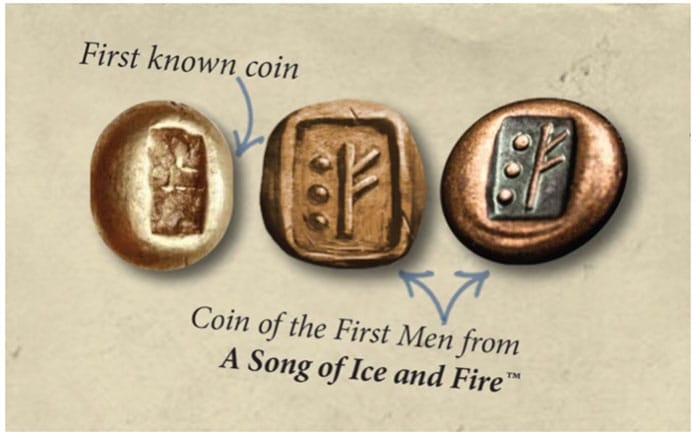
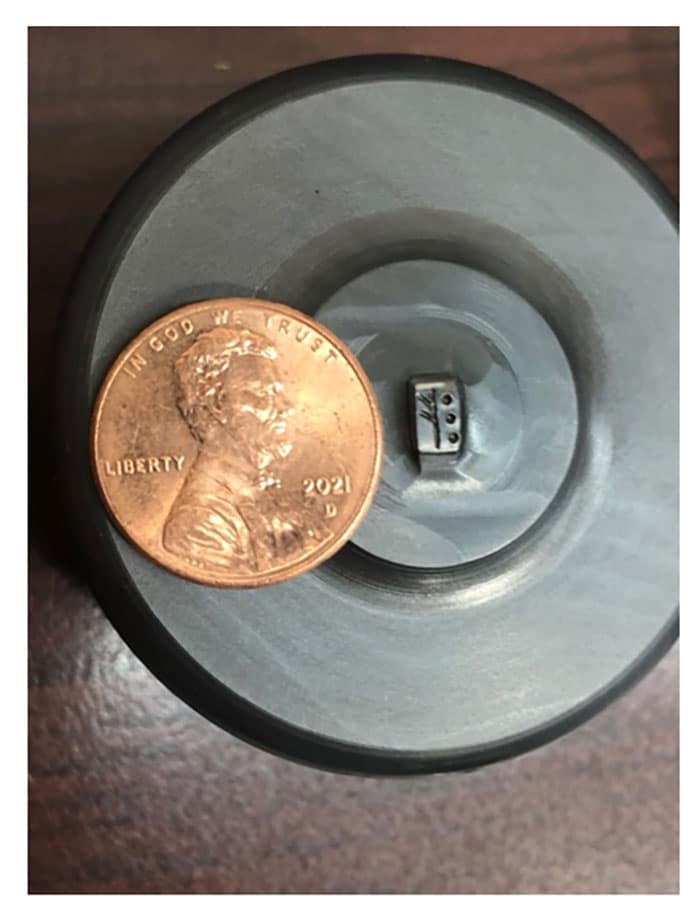
The Walder Frey Penny
This small copper penny, the size of a modern U.S. nickel, is extremely interesting and well designed. On the obverse can be seen an effigy of Lord Frey as a young man. But the coin’s date, 299 AC, being contemporary to the beginning of the original Game of Thrones series in 298 AC, would indicate Walder Frey was much older. This was a common practice on many pre-modern coins, where the obverse bust of a ruler would either not be updated regularly or, like on Augustus Caesar’s coins, depict a perpetually young man. The abbreviated legend, L.O.T.C, which stands for “Lord of the Crossing”, is typical as well. It was common to abbreviate regnal titles in order to fit everything into the limited space.
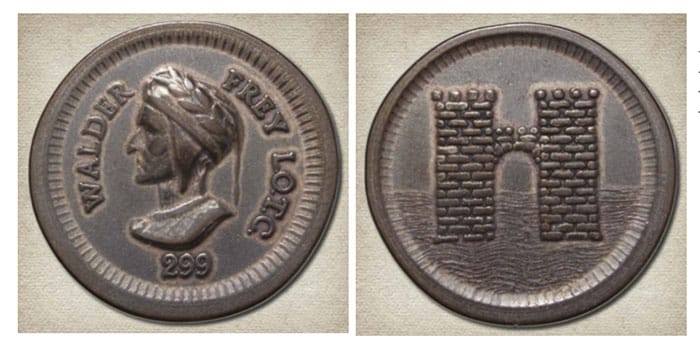
Not only does this penny fit the in-world personality of Walder Frey but it also is quite interesting numismatically. The obverse bust is highly reminiscent of the 1495 painting by Sandro Botticelli of Italian poet Dante Alighieri. In fact, the bust is based on a vintage die hub engraved by Stan Pearson depicting Dante.
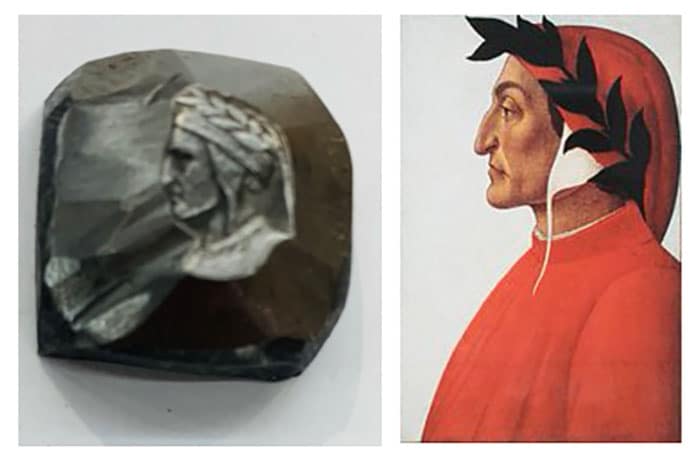
While a century out of time (the story’s medieval age is approximately 100 years prior to the Renaissance), it fits the fabric of the coin and the reverse design – especially since depictions of cities and castles have been numismatic conventions for thousands of years. On Roman coins, it was the city gate. On medieval coins, it was a stylized castle tower. And on Renaissance coins it was a more realistic cityscape. The design of this specific coin straddles the line between medieval and Renaissance and fits the story very well.
Even more interesting than the standard coin are the three cursed Walder Frey pennies. These coins are the same as the standard version, save for the obverse damnatio memoriae. Walder Fray’s bust is disfigured by a ritualized curse in response to the Red Wedding. One Penny is marked with an X, another with the skull and crossbones, and the third a female figure named Caetlyn’s Curse. While unusual and mainly occurring on ancient coins, this is a highly realistic practice committed against especially hated rulers.
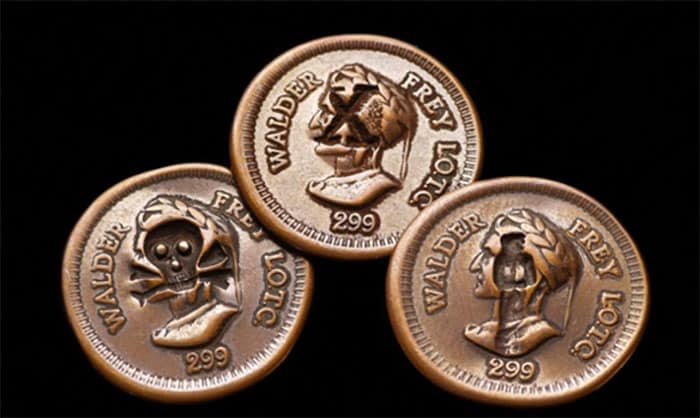
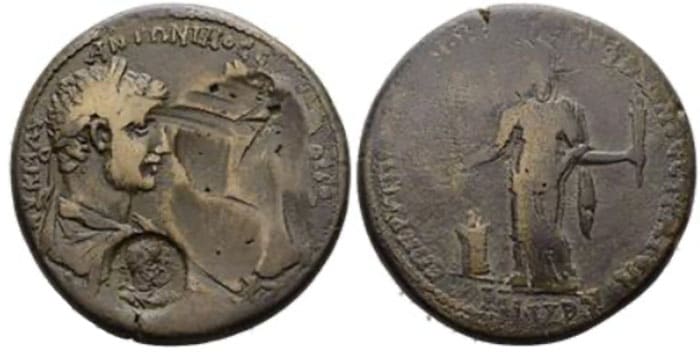
Braavosi Iron Square
Across the Narrow Sea from Westeros lies the free city of Braavos, home of the famed Iron Bank. An unusual square coin struck from iron, this piece is a fascinating mix of real-world cultures. Several peoples used square coins, most notably the Indo-Scythians, the Mughals, and the Bactrians, all of which were considered Eastern powers. The obverse depicts a Braavosi military helmet flanked by two swords and the legend Iron Bank – Braavos. The legend, while in English, appears to be in a Sanskrit-type font.
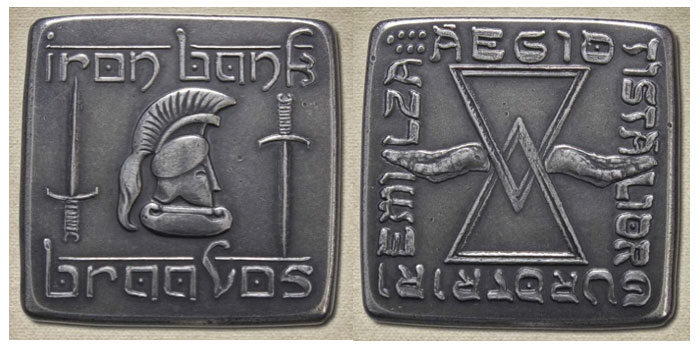
On the reverse, an hourglass with two hands is surrounded by the High Valyrian legend, Āegio Tistālior gurotriri emilza. This translates as “The Iron Bank will have its due”. Unlike the obverse legend, this text seems to be in a Hebrew-type font. This works since the two legends are in different languages. Otherwise, it is standard practice in real-world numismatics to use the same font on both faces. Woody Maringer, the artist in charge of this piece, discussed how the design process and the necessity of creating a series of pattern types mirrored that of the real world. This image of the first pattern type obverse die and of an example of the final coin shows how the obverse design evolved.

Dothraki Copper Pul and Silver Denga
From the far east, the home of the Dothraki hoards, come the copper pul and silver denga. “Adamant” that the Dothraki are not a monetary culture, Martin instead depicts the nomadic horsemen as using a system of barter and gift giving. However, they will strike a specially prepared wire with dies, repeatedly and in series, but only to be used as detailed bracelets and armbands. This jewelry, when captured by city-dwelling people upon the death of a Dothraki, can later be cut up to produce coins.
These coins are reminiscent of real-world coins struck by Russia’s first tsar, Ivan the Terrible (ruled 1547-1584). Not only did Ivan have a wire type coin denominated as a silver denga, but his coins also depicted a sword-waving horseman on the obverse and multiple lines of text on the reverse. The Russian coins were very small and measured less than 1 cm, unlike the Dothraki denga, which measure 3.8 cm.
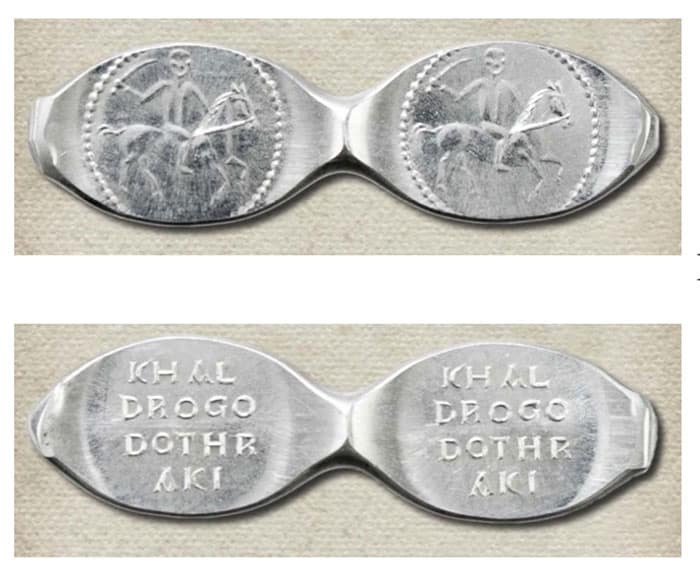
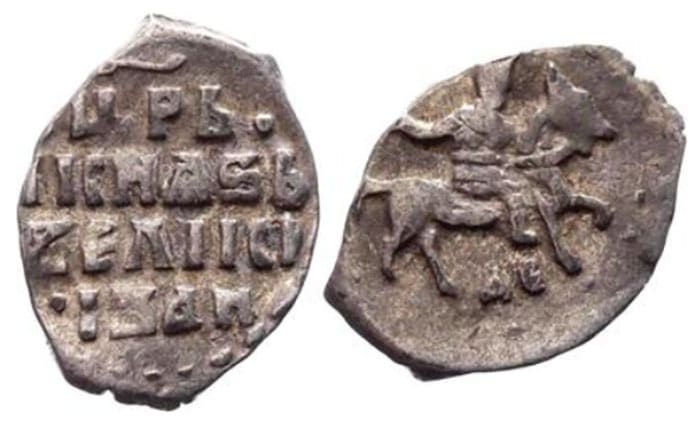
However, the Dothraki were not patterned on the Russian coins of the early 16th century but instead are more reminiscent of the 13th- and 14th-century coinage of the Mongol Khanates. The Mongols most certainly struck coins during this time period and even had a copper coin called the Pul or Pulo. While often irregularly shaped, these were not wire-type coins. This is demonstrated by the bronze Pulo of Berke Khan, a grandson of Genghis Khan who became a successful military commander and ruled the Golden Horde from 1257 to 1266, seen below.
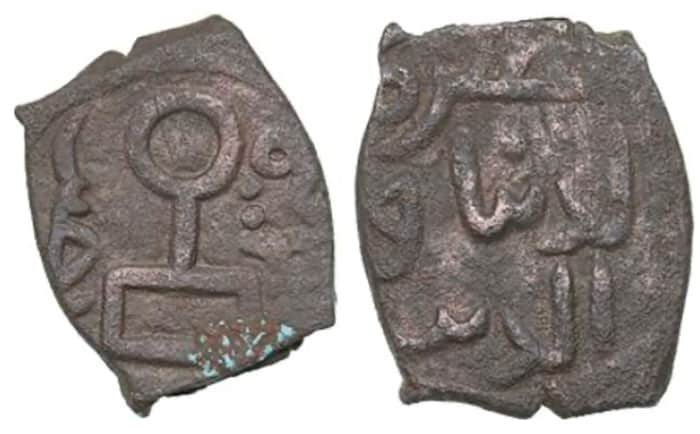
While there may be some small design decisions that do not correlate perfectly with real-world numismatics, with the input from George R.R. Martin and his co-authors, the Shire Post Mint’s skilled designers and engravers have produced numismatic designs that are very faithful to the Game of Thrones world. Even more importantly, Tom Maringer and his team are helping to bring coins into our modern zeitgeist and consequently breathe life into the small numismatic community. The Shire Post Mint’s Westerosi offerings even appear in Krause Publications’ Unusual World Coins: Companion Volume to the Standard Catalog of World Coins, 6th Edition! Numismatics is not only about making money or million-dollar sales, and this series of very interesting and collectable fantasy coins needs not appeal to just fans of Game of Thrones.
* * *
Sources
Telephone interview with Tom and Woody Maringer. September 16, 2022.
https://awoiaf.westeros.org/index.php/Currency
https://www.goodreads.com/book/show/4387283-unusual-world-coins
https://thehistoryofengland.co.uk/resource/medieval-prices-and-wages/
https://gameofthrones.fandom.com/wiki/Currency
http://www.fordham.edu/halsall/source/medievalprices.html#HORSES
https://kyiv2014.com/wire.html
https://www.metaldetectingworld.com/hammered_wire_silver_coins.shtml
https://www.shirepost.com/blogs/news/how-a-fantasy-coin-is-made
https://www.westeros.org/Citadel/SSM/Entry/1243
* * *
About the Author
Tyler Rossi is currently a graduate student at Brandeis University’s Heller School of Social Policy and Management and studies Sustainable International Development and Conflict Resolution. Before graduating from American University in Washington D.C., he worked for Save the Children creating and running international development projects. Recently, Tyler returned to the US from living abroad in the Republic of North Macedonia, where he served as a Peace Corps volunteer for three years. Tyler is an avid numismatist and for over a decade has cultivated a deep interest in pre-modern and ancient coinage from around the world. He is a member of the American Numismatic Association (ANA).




